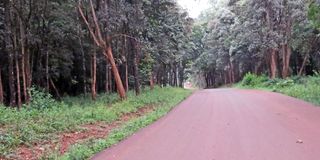Mahogany: Beautiful hardwood tree that now faces extinction

Brachylaena huillensis (mahogany) or muhugu in Kikuyu on the sides of a road. The tree is a favourite among wood-carvers. PHOTO | FILE | NATION MEDIA GROUP
What you need to know:
- Mahogany has multiple uses that include timber, fuel, carvings, construction and fencing.
- An essential oil distilled from the wood has a pleasant perfume. It is the source of mahogany oil, used in making soap and perfumes.
- Studies have shown that the tree is fast-disappearing in its native ranges, a victim of its own commercial value, especially in carving.
- According to the World Conservation Monitoring Centre, mahogany’s extinction may cause the collapse of the carving sector, which plays a crucial role in employment creation and earns foreign exchange through exports.
Brachylaena huillensis (mahogany) is native to Angola, Kenya, Mozambique, South Africa, Tanzania, Uganda and Zimbabwe.
Its common English name is silver oak or mahogany. In Kikuyu, it is known as muhugu.
According to Kefri’s Guide to Tree Planting in Kenya, it grows in zones with an altitude ranging from 200 – 1,850 metres above sea level and annual rains of between 800 and 1,400mm.
Benefits
Mahogany has multiple uses that include timber, fuel, carvings, construction and fencing.
It is a favourite of wood carvers, who mainly supply the tourism industry and export markets.
The wood is notable for its high durability in the soil and resistance to fungal and insect attacks. It is used in flooring, furniture and joinery.
During the first two decades of the 19th century, this wood was the main source of fuel for Kenya.
It was also exported to India as a substitute for sandalwood for use in cremations.
It also fixes nitrogen in the soil and so it can be grown with crops.
An essential oil distilled from the wood has a pleasant perfume. It is the source of mahogany oil, used in making soap and perfumes.
Threats
Studies have shown that the tree is fast-disappearing in its native ranges, a victim of its own commercial value, especially in carving.
One study, by Dr Jane Mutinda of the School of Environmental Studies, Kenyatta University, found that the tree had been cut into extinction in Wamunyu, Machakos, the hub of the carving sector.
Today, the estimated 200-300 tonnes of wood per week that artisans use are trucked in from forests such as Karura and Ngong, where it is also vanishing – fast.
Others are smuggled in by illegal loggers from as far away as Tanzania and Mozambique.
The Mombasa and Malindi carving centres use 20,800 trees each year, felled from some of the last remaining natural forests on the Coast.
A Centre for International Forestry Research (CIFOR) report, Planning for Woodcarving in the 21st Century, notes that given the rate at which these trees are being harvested in Arabuko Sokoke forest, they will be extinct in less than three decades.
Mahogany was once dominant in Karura forest but it is commercially extinct today.
That Karura forest is hardly a kilometre from the Kenya Forestry Service headquarters points to the power and influence of the loggers.
The International Union for Conservation of Nature has classified the tree as 'near threatened' in its Red List of Threatened Species.
According to the World Conservation Monitoring Centre, mahogany’s extinction may cause the collapse of the carving sector, which plays a crucial role in employment creation and earns foreign exchange through exports.
However, if the massive felling of trees such as mahogany is not checked, it will lead to a major ecological disaster.
According to conservationists, what is needed is a change in attitude among wood carvers and buyers.
Some steps have been taken in this direction, like creating awareness among the carvers through theatre, campaigns among the buyers and importers where they are advised not to buy products made from the wood of rare trees.
Another significant step taken towards preservation is to invest a certain percentage of earnings in nurseries. Domestication of the tree is also encouraged as it will ease pressure on the natural populations.
Propagation
Mahogany is normally propagated by seed, which cost Sh5,000 a kilogramme at the Kenya Forestry Research Institute.
But the seeds are delicate as their viability is lost within six months. They should be sown in well-prepared beds of soil mixed with sand.
No pre-sowing preparation is needed and the seeds germinate within two to three weeks. Seedlings should be planted during rains to give them a better chance of survival.
According to the researchers, this tree grows very slowly and it takes up to a century for it to reach just 40cm in diameter.




